Exploring Kolmanskop: Namibia’s Ghost Town in the Desert
I ducked beneath the barrier and jogged across a nearby sand dune.
When I reached the first derelict building, I looked behind me and shot Dave an exhilarated grin.
I’ve been a rule-follower for much of my life, but I was learning that disobeying authority was kind of invigorating. I couldn’t wipe the smile from my face.
There I was, standing in the centre of a Namibian ghost town, surrounded by desert, and Dave and I were the only people around.
The town was dark, eerie, and foreboding; the only sound the thudding of my heart and gentle crunch of sand underfoot.
I took Dave’s hand in mine, crept forward a few feet, then ducked into the abandoned remains of somebody’s home.
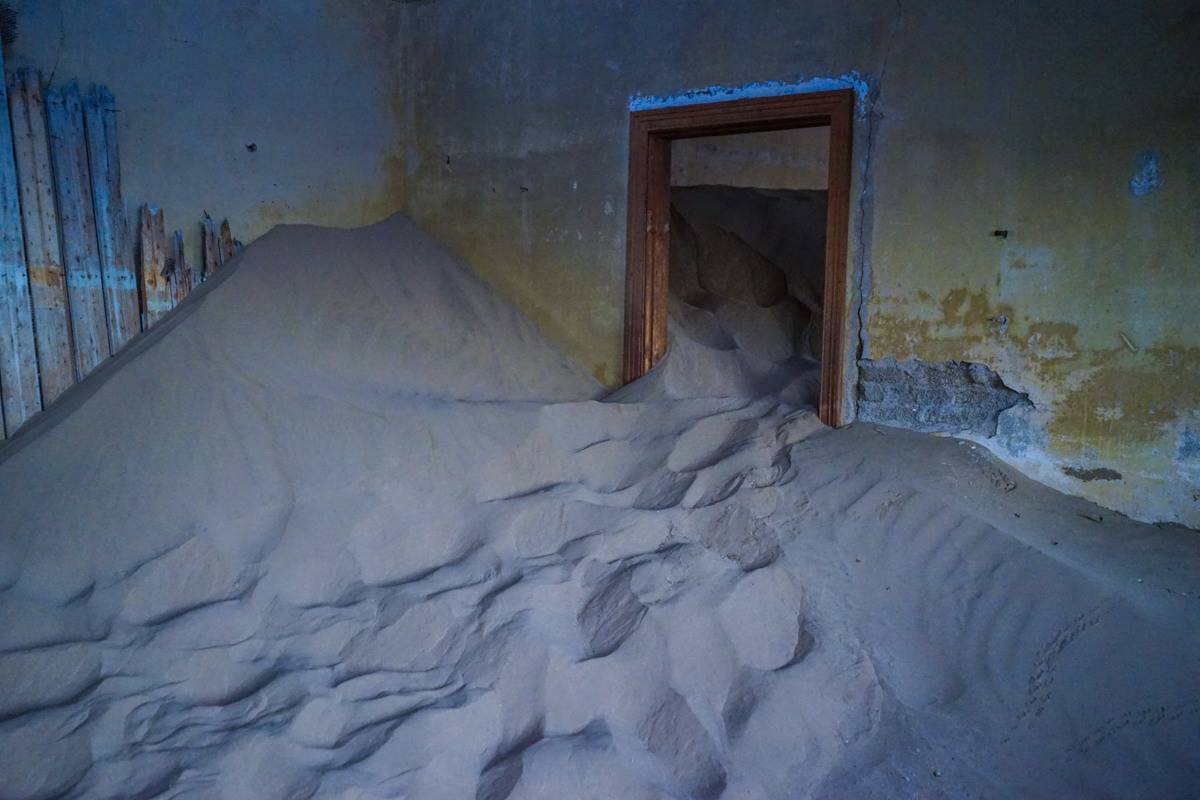
We had driven 1,500 kilometres (1,000 miles) out of our way to get here, and on Namibia’s bad roads, that equals a seriously big undertaking.
With just two weeks to see Namibia’s highlights, we had packed a ton into our time so far — easing into the trip in Ovita, three days of rhino-spotting in Etosha, gazing at incredible rock formations in Vingerklip, laughing at seals in Swakopmund, climbing sand dunes in Sossusvlei — but now it was time for the main event. The entire reason behind our trip to this beautiful country.
Because as soon as I’d spotted those cheap flights to Namibia, the first place I’d thought of had been Kolmanskop. And even though it made zero sense to go there, given the itinerary we’d put together, I was determined to see it. Even if it was going to involve a thousand-mile detour to get there.
And plus, I wasn’t the one who was driving.
Lol, sorry Dave.
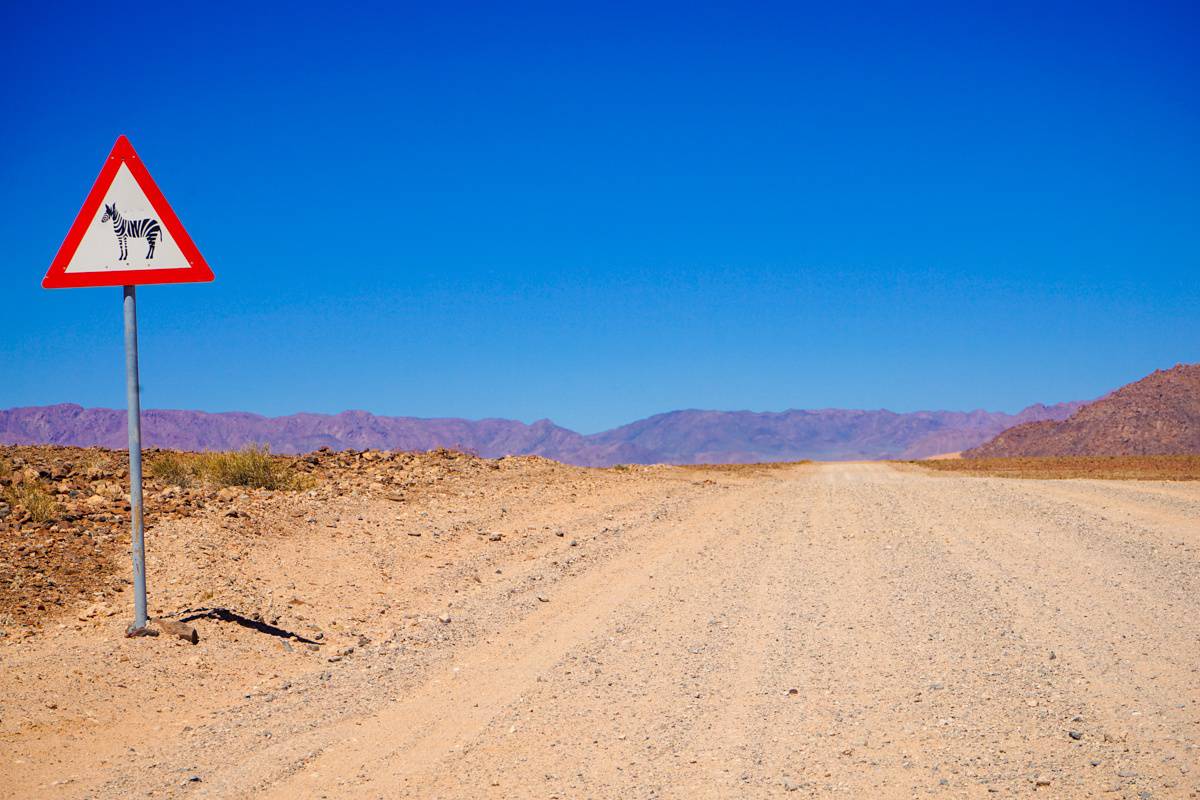
A thousand miles doesn’t sound so bad, until you realise this is the quality of the roads you’ll be driving on
So what even is Kolmanskop?
Back in 1908, workers were building a railway through the Namibian desert when one of them stumbled upon a diamond. By 1912, the site of that discovery marked the settlement of Kolmanskop, a diamond-mining town that was home to 1,300 inhabitants, as well as a hospital, pub, casino, ballroom, and even an ice factory.
Back then, the town had the highest level of wealth per capita and workers mined 12% of the world’s diamonds. In fact, over the first six years of mining, a whopping five million carats worth of diamonds were extracted. That wealth translated into some seriously luxurious living: Kolmanskop was home to the first tram in Africa, as well as the first X-Ray machine in the southern hemisphere.
Water was transported in for miles by train, and used solely to keep the residents’ lush gardens flourishing. The ice factory was built to allow the town to produce their own fresh lemonade. The mine paid for opera companies to ship performers from Europe out to Kolmanskop to perform in their concert hall. One of the residents even kept a pet ostrich for a period of time.
Kolmanskop continued to thrive for several decades until it was finally abandoned in 1954. The diamonds were no longer easy to find and other parts of the desert proved to be even more lucrative. After the last resident left the town, the desert slowly began to reclaim what was once sand.
Over the past 70 years, these now abandoned homes have been battered by the desert. Windows, doors, and ceilings have blown in, with the wind carrying sand into what was once occupied, piling it high in every room.
Now, Kolmanskop is a ghost town, decaying in the Namibian desert, and just asking to be explored. Fortunately, that’s exactly what I was about to do.
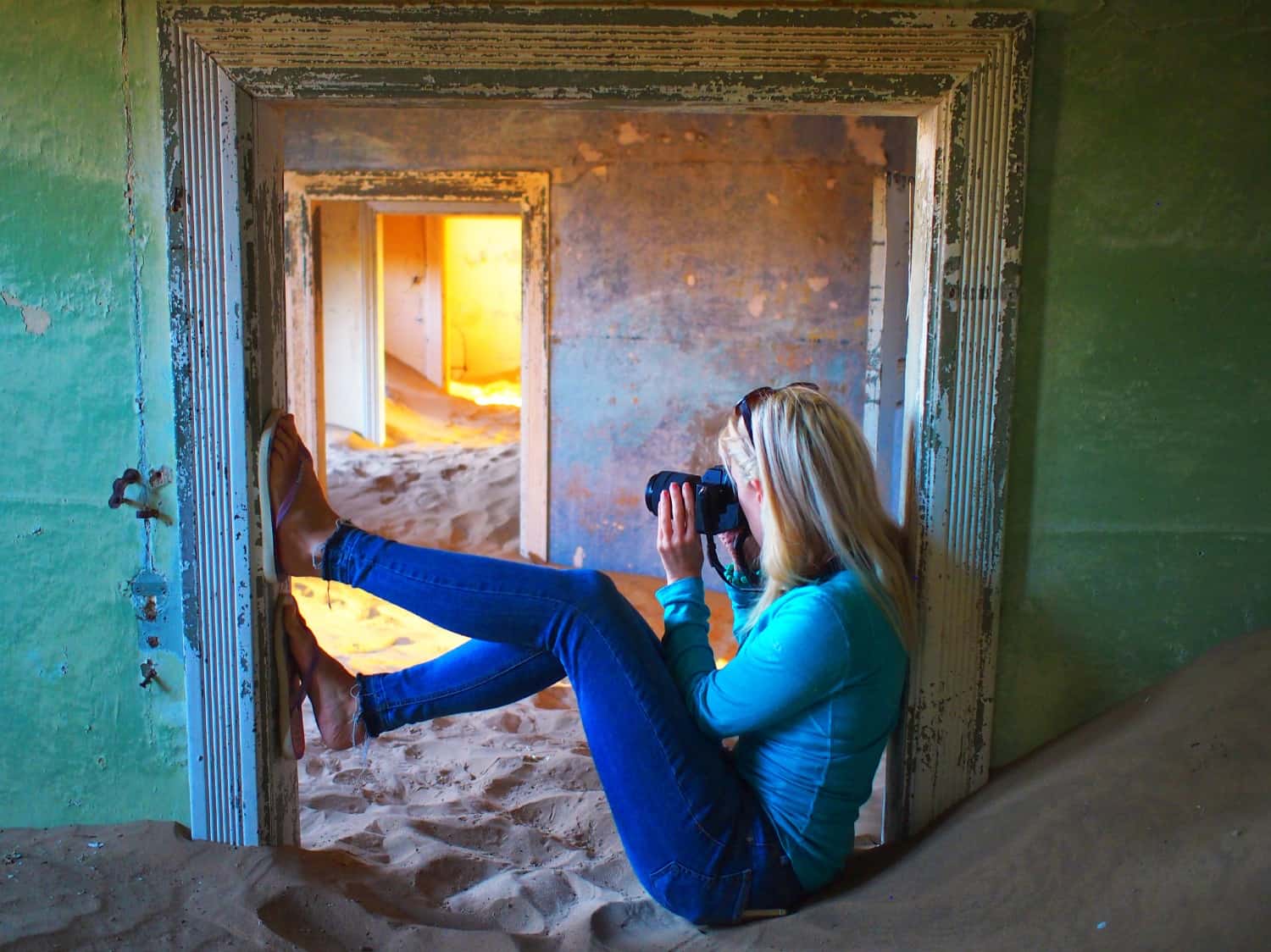
Yes, this is, in fact, the very natural position I take all of my photos in, why do you ask?
Today, you need a permit to visit Kolmanskop. You can grab a standard ticket at a cost of 85 NAD ($6.50) and enter at 9 a.m. or pay 230 NAD ($16) for a photography permit that’s valid from sunrise to sunset. I wanted to explore Kolmanskop without tour groups and crowds, so a sunrise visit was the only visit for me.
When our alarm went off at 5 a.m. and we had to drag ourselves out of bed the following morning, I was kind of regretting that decision. When we arrived at the gate and the guard was nowhere in sight, I was regretting it even more. The sun was starting to rise and there was nobody to buy a permit from. I saw my chance at exploring the buildings alone fading.
We parked our car then looked around. We were the only people in sight.
“Should we… just… go in?” I asked Dave.
“I dunno. There’s nobody here.”
“I mean the permit gets us in from sunrise and it’s basically sunrise. The guard isn’t here! And it’s not like we’re not going to pay. We’ll just come back and pay when he gets here.”
Dave thought for a second.
“Come on!” I urged him. “Let’s just walk in.”
“Okay.”
We grabbed our cameras, locked the car, and ducked beneath the barrier beside the guard’s office.
And that was how we broke into Kolmanskop.
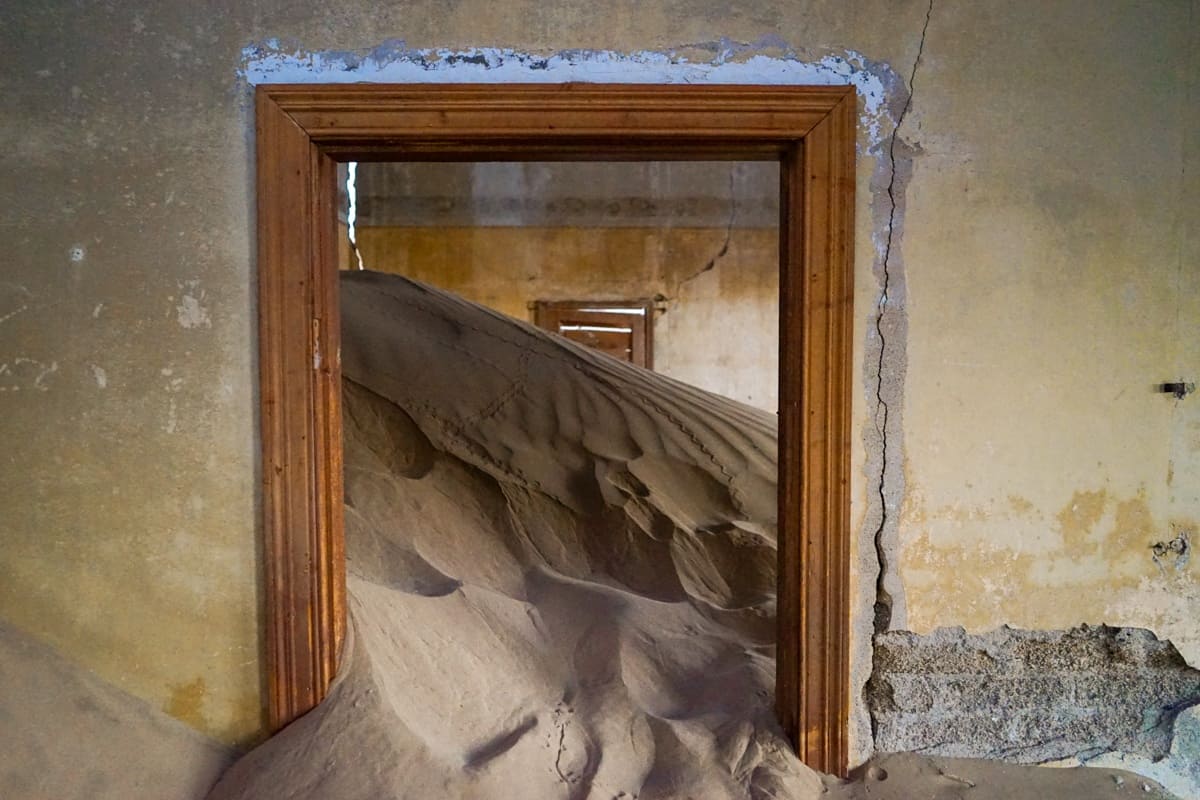
There’s something so bizarre about having to duck through a doorway when you’re 5’1”
And now: a warning.
Writing this blog post has taken me over two years because the prospect of sorting through 400 photos, all of which I wanted to share with you guys, was ov-er-whel-ming. Last week, I finally sat down and finished editing them — the completed blog post contained sixty five photos. Don’t worry — I’ve reduce them to a, uh, slightly more manageable number over the past few days.
But needless to say, Kolmanskop is so freaking cool that I ended up with too many photos and it took me literal years to whittle them down into one blog post. It’s so hard to put into words and photos just how incredible of a place it is.
It was easily one of my highlights from the past eight years of travel.
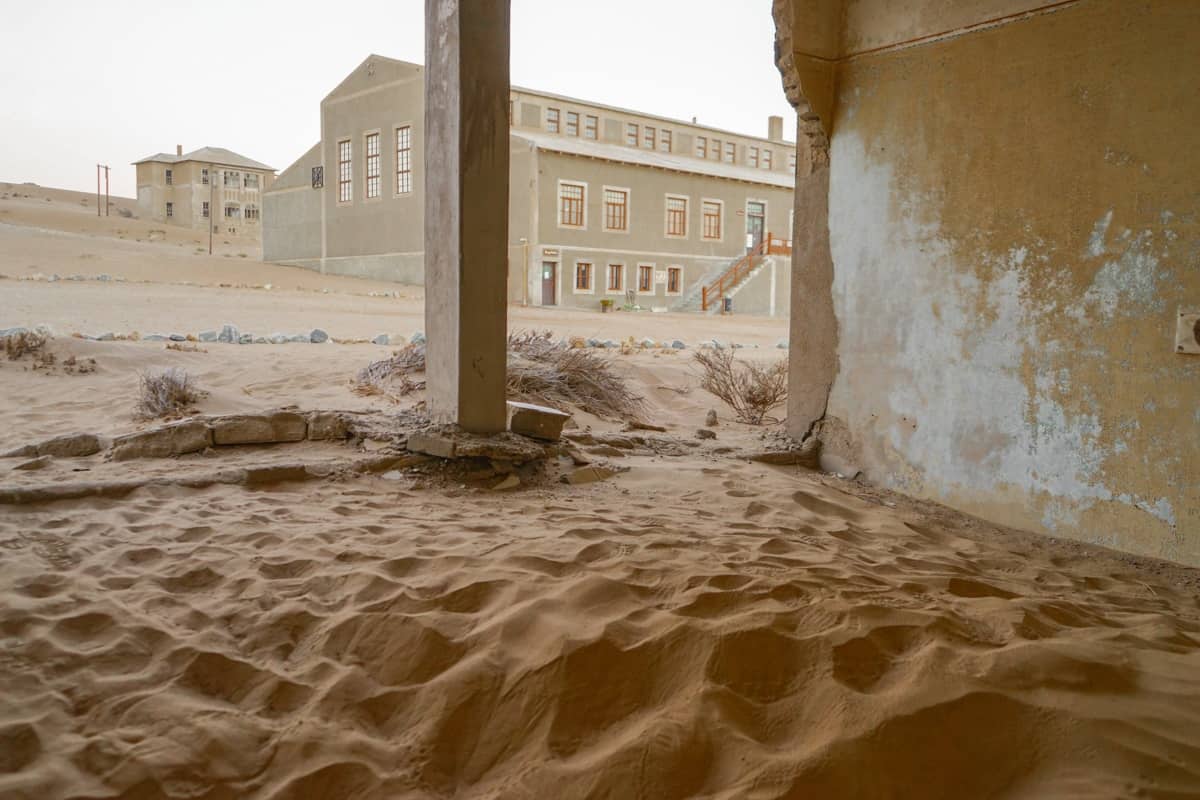
When we first arrived, the colours of Kolmanskop were washed out and dull, but that would soon change
The sun was creeping above the horizon when we reached that first building, but as we walked inside, it was shrouded in darkness. I could barely see a thing as I dropped to my hands and knees and crawled over the cold, clammy sand.
“This is creepy,” I murmured to Dave.
Everything felt eerie at this time of day. The buildings of Kolmanskop stood silent and cool, forcing me to turn on the torch of my phone and illuminate the piles of sand in front of me.
While I’d seen countless photos of Kolmanskop before I arrived, it was nothing like being there in person. The surrealism was something I couldn’t get my head around. I just can’t even describe how bizarre it is to see a full-on desert inside a house, sand dunes blown ten feet high, to the point where you have to shimmy under a door frame on your stomach in order to fit through.
One thing I love about ghost towns is how much they get me thinking about the people who once lived there. How this was their home and now it’s completely abandoned and some random loon of a travel blogger is scrambling up sand dunes in what was once their kitchen.
Back in the 1950s, residents couldn’t have imagined what the future held for the homes they were living in.
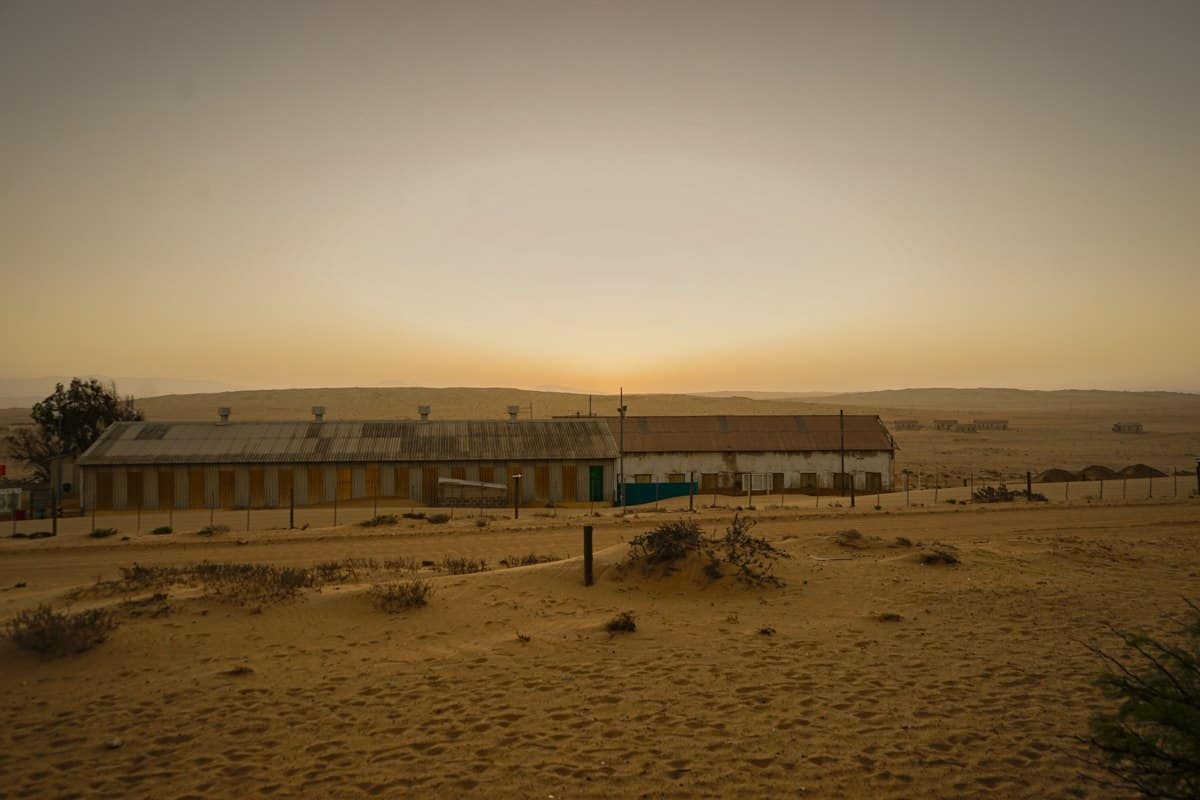
As the sun inched higher in the sky, I scrambled up to the second floor of a building to gain a better vantage point over the ghost town. Moments later, it brought a sudden warmth into the rooms, forming new shadows across the sand.
When we’d first arrived, the rooms had felt cold and menacing, on the verge of being haunted. But as the warm orange glow of the sun started to fill the rooms, it felt like a different place entirely. Somewhere beautiful rather than forbidding, and I was eager to head back to the buildings I’d just finished exploring to see what they were like in a different kind of light.
Suddenly, Kolmanskop felt welcoming.
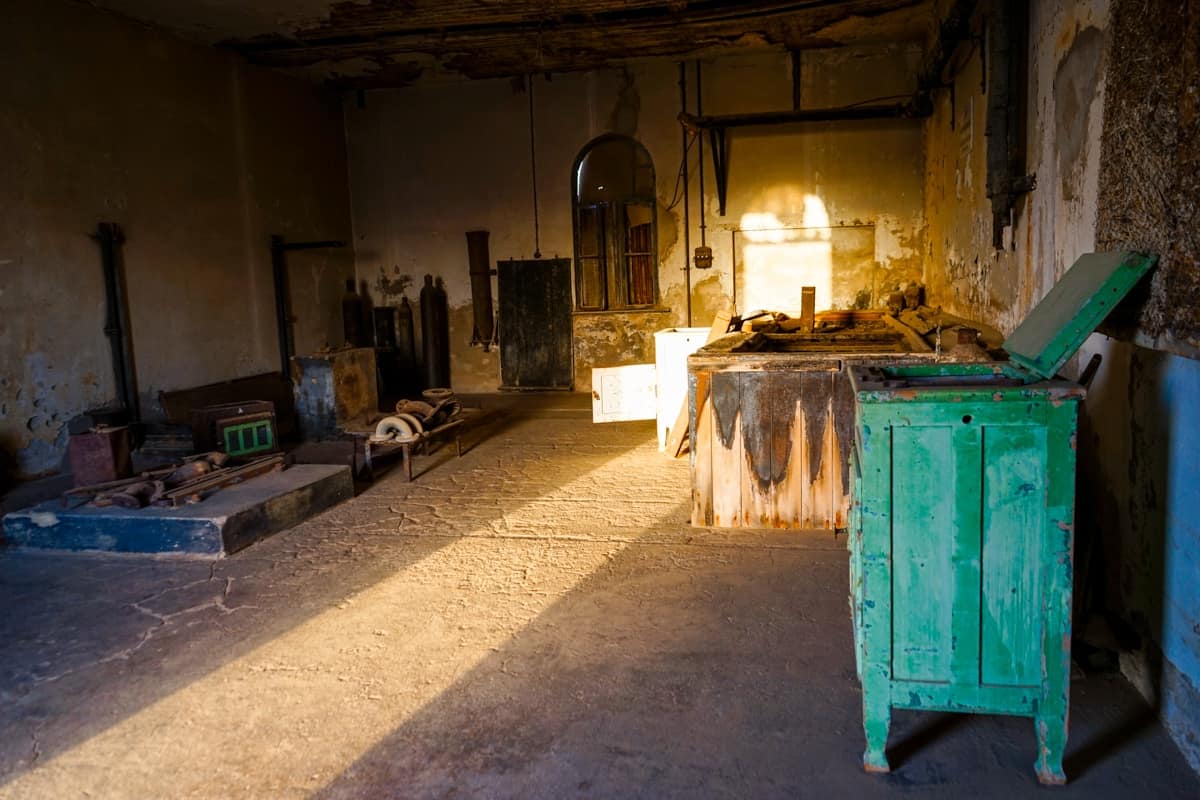
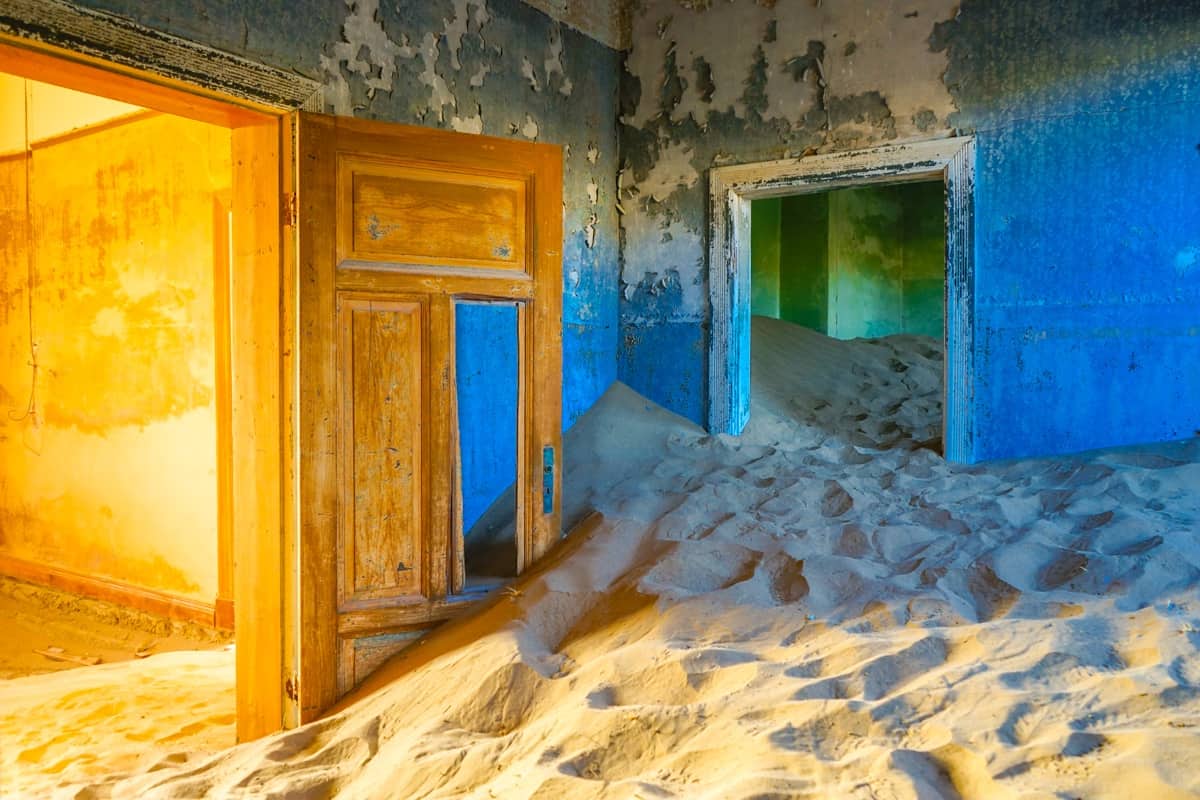
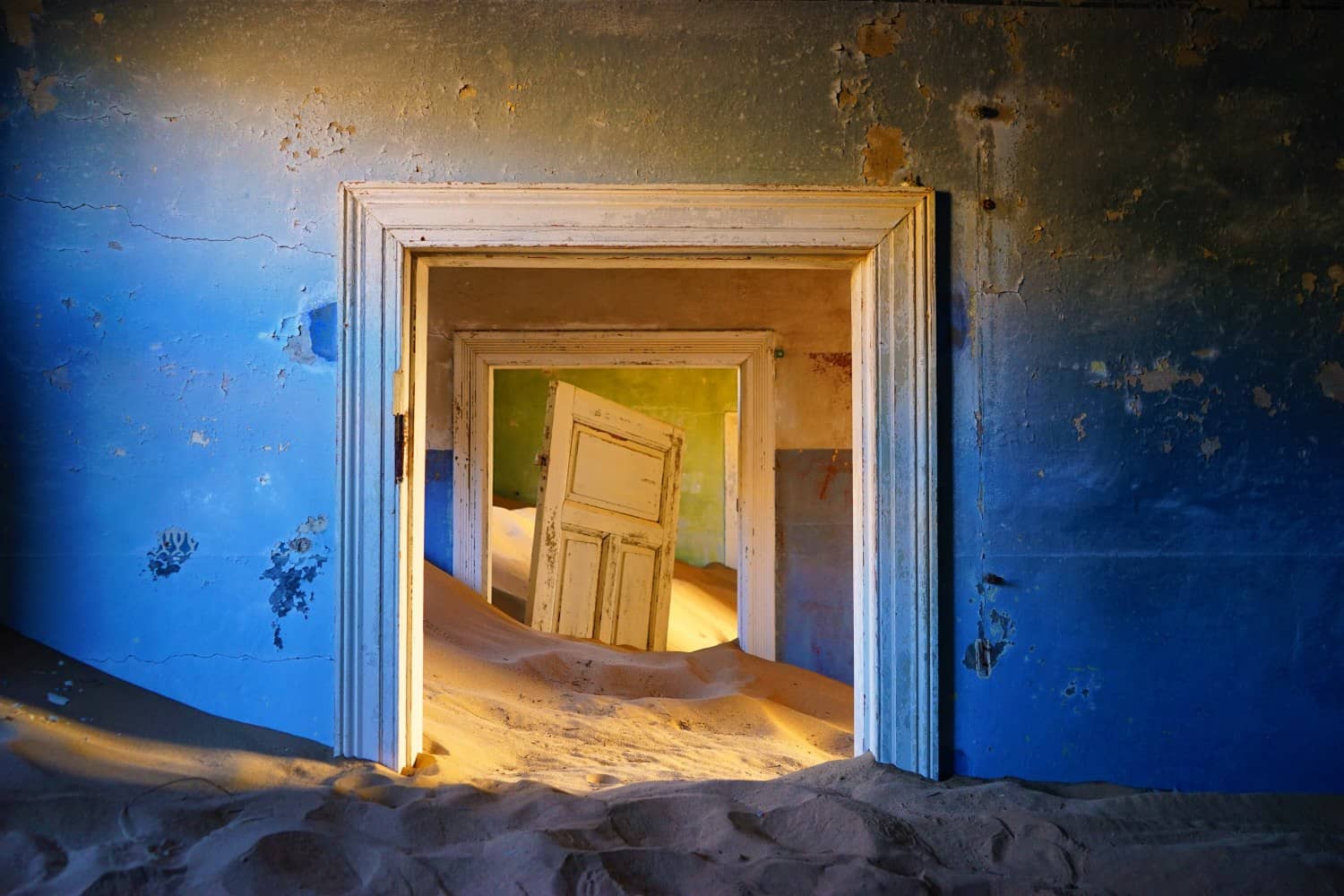
Probably my favourite photo from Kolmanskop! I love how the door is angled in the sand
There were dozens of buildings to explore, and I was surprised to discover they each had something different to offer up. Before arriving, I’d assumed each house would blur into the next; there’d be a couple of rooms full of sand and then the next building would have a couple of rooms full of sand, and they’d all kind of look the same.
Instead, there were different paint colours on the walls; different tiles in the kitchens. The blue rooms gave a stark feel to my photos, while the orange and yellow paints gave off a rich warmth. Some of rooms had floorboards and some had gaping holes where they’d long ago collapsed. A handful of buildings were home to just a thin layer of sand, while the rest had towering dunes that engulfed the doors and stretched towards the ceiling. A couple of homes weren’t accessible from the front, so you had to wander around the side and squeeze through what was once a window.
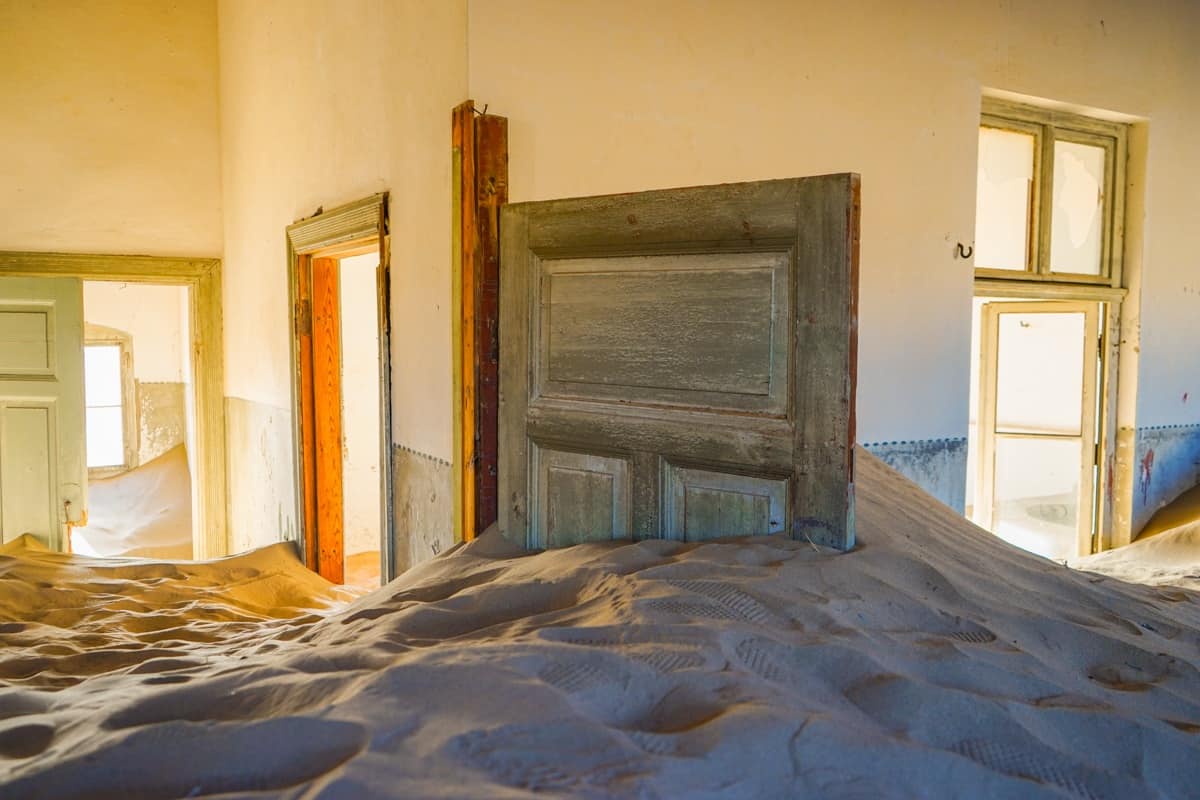
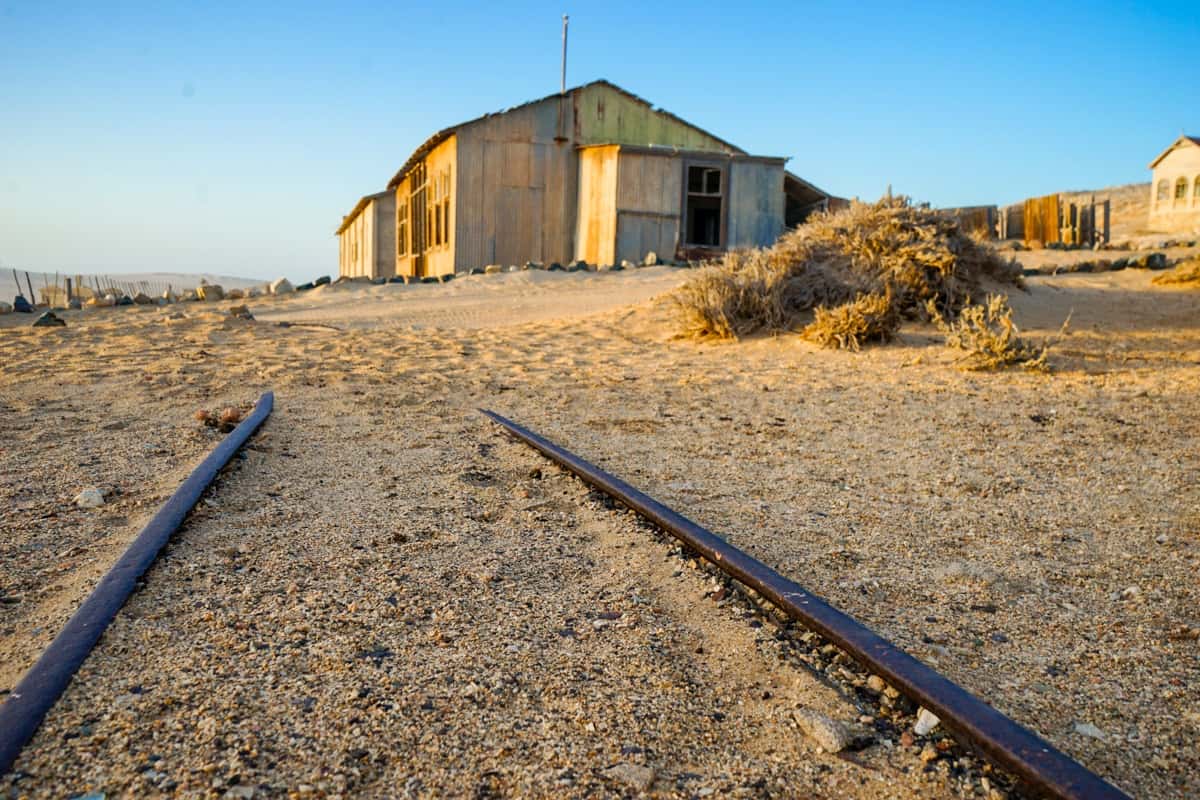
I was in the middle of climbing through said window when I heard a shout from the building next door. Quickly squeezing back out, I poked my head around a wall to see what was happening.
Uh oh.
The guard had turned up, spotted our permitless car, then rampaged through the town to find the people who had sneaked into Kolmanskop.
Oops.
I watched Dave meekly being led away by the guard, then decided to keep exploring with a shrug. I knew he could handle things and I was desperate to see as much of the complex before any other tourists arrived.
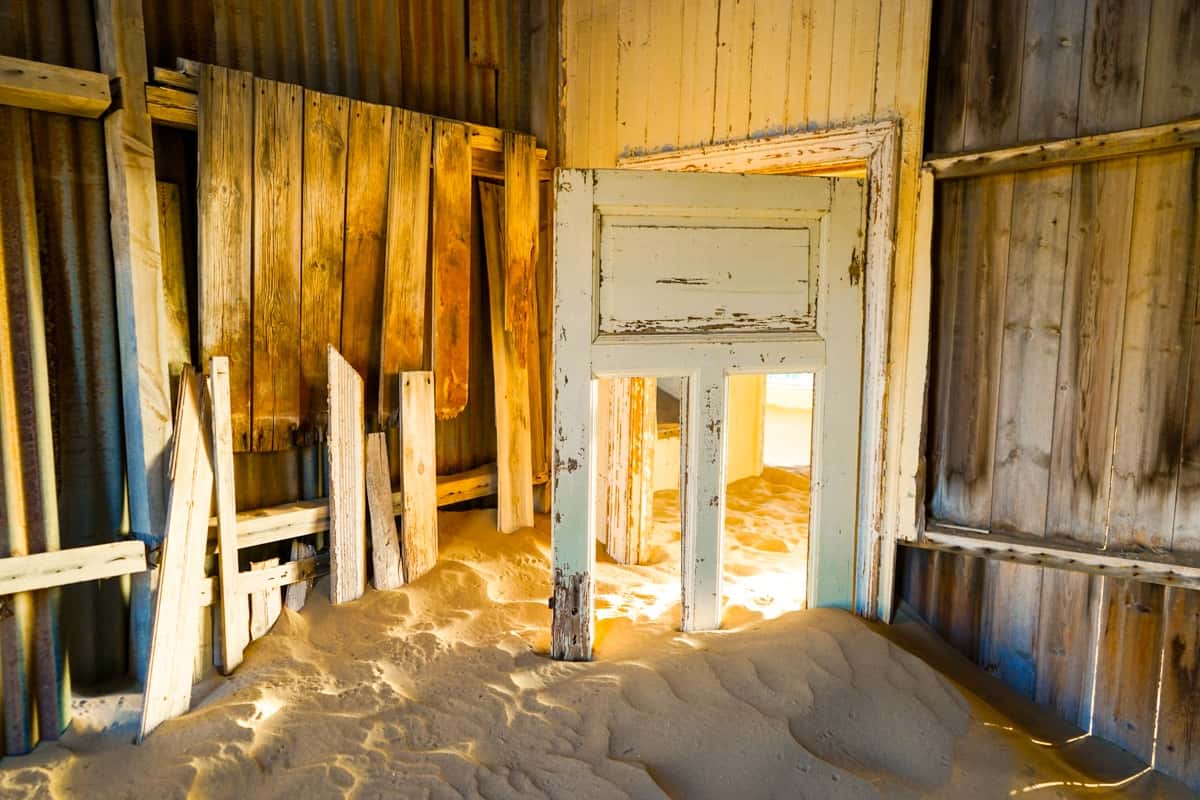
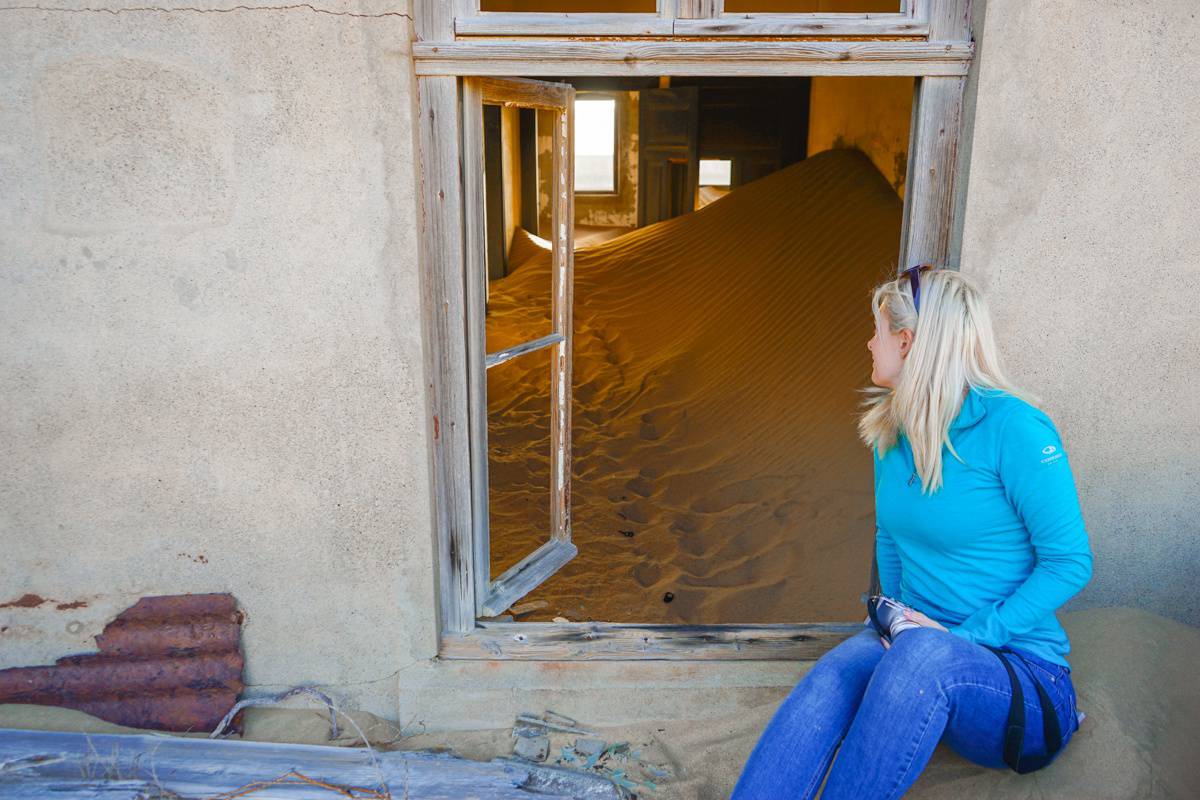
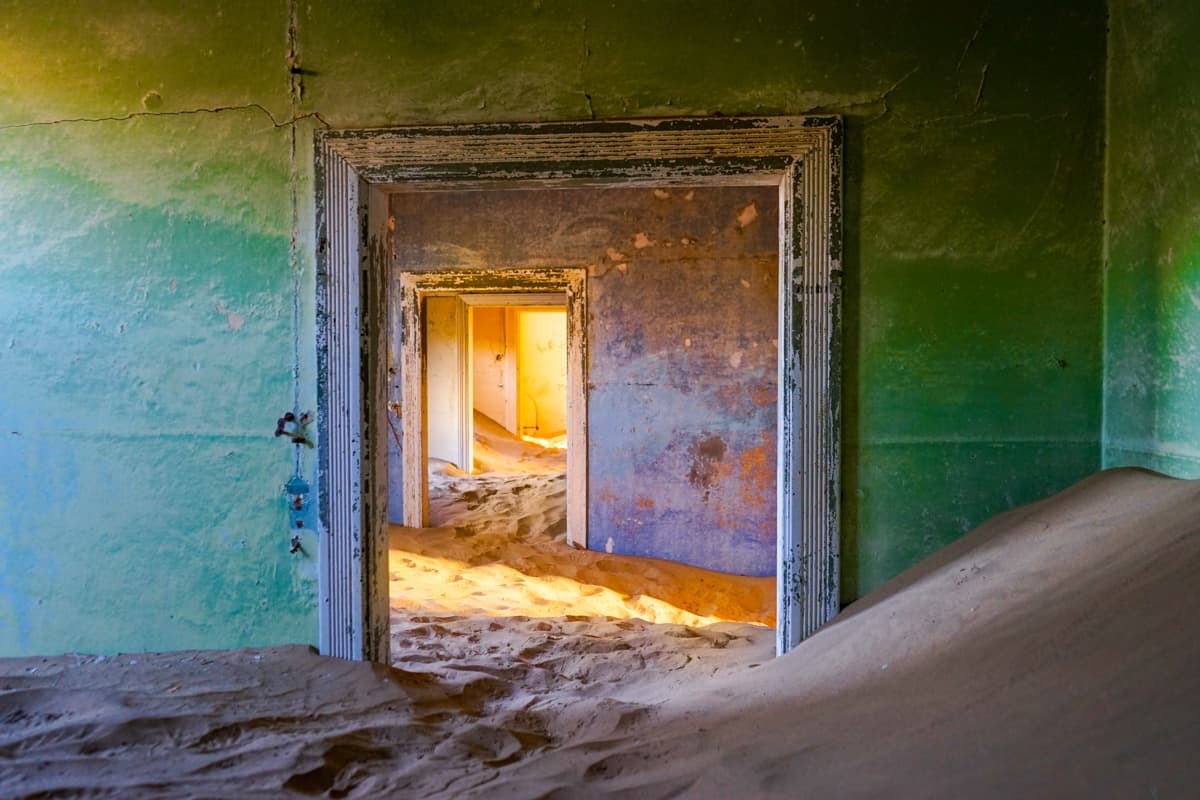
This was the most magical moment for me.
We would have a solid hour to ourselves at Kolmanskop before anyone else turned up, and being here alone made the experience all the more incredible. The sun was casting golden rays through the buildings, parts of the sand had yet to be trampled over, and the only sound was my breathing and the continuous click of my camera shutter.
I reunited with Dave, who had been well and truly chastised by the guard, and we continued to make our way through the buildings.
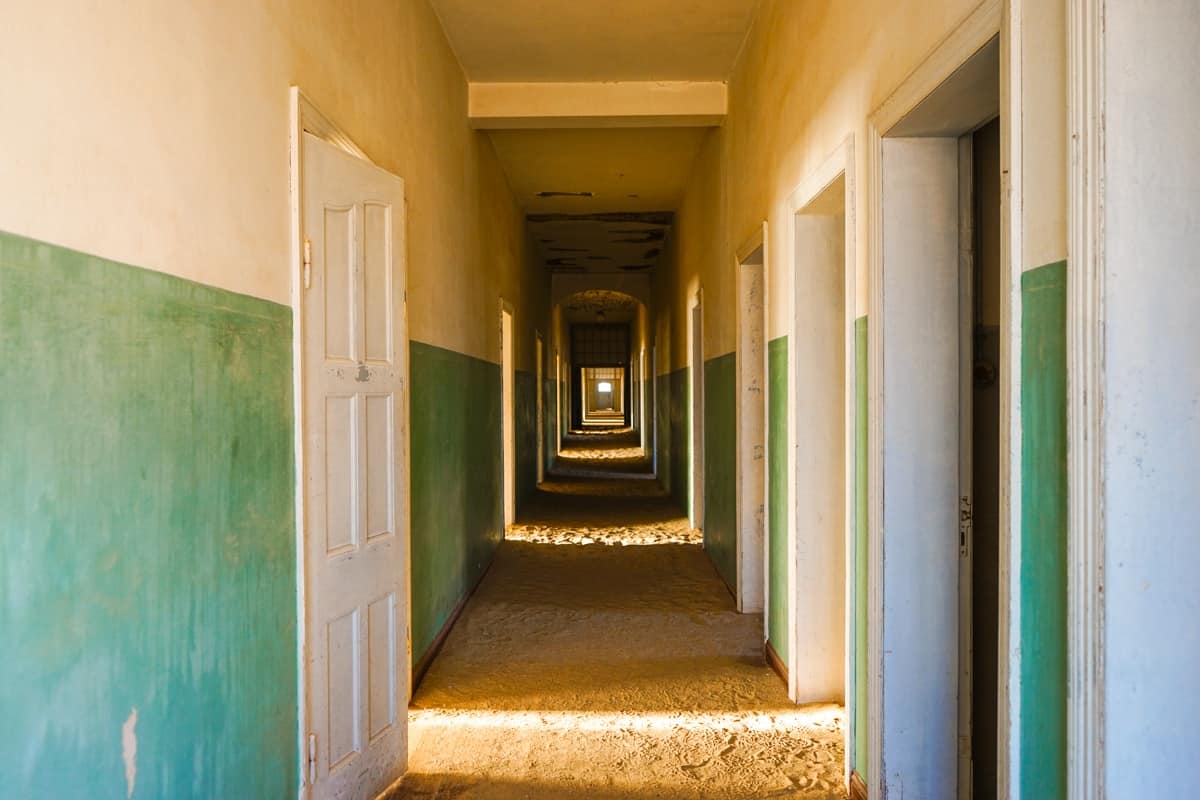
I’ll be honest here and confess that I’ve kind of run out of words to use with my photos… and that shockingly, I still have a lot of photos I want to share.
So I’m gonna shut up now, and just share a bunch of my favourite photos from the rest of the time I spent exploring at Kolmanskop.
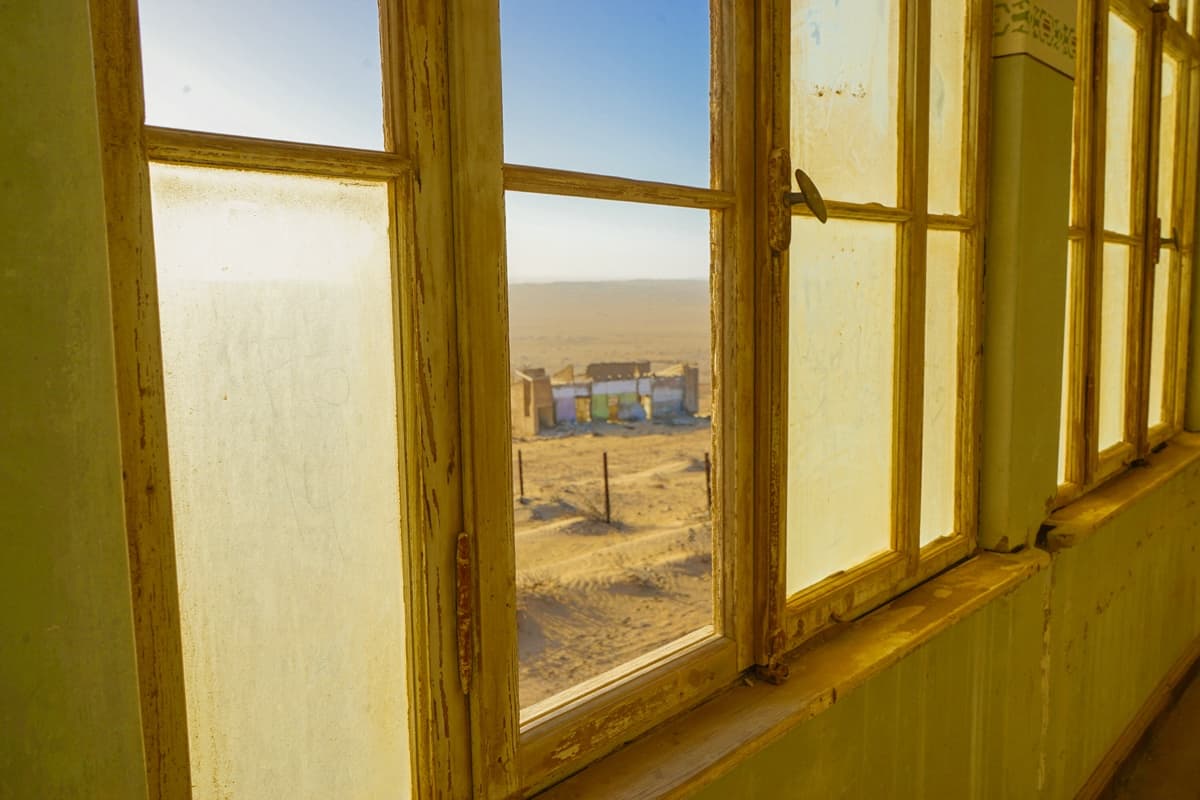
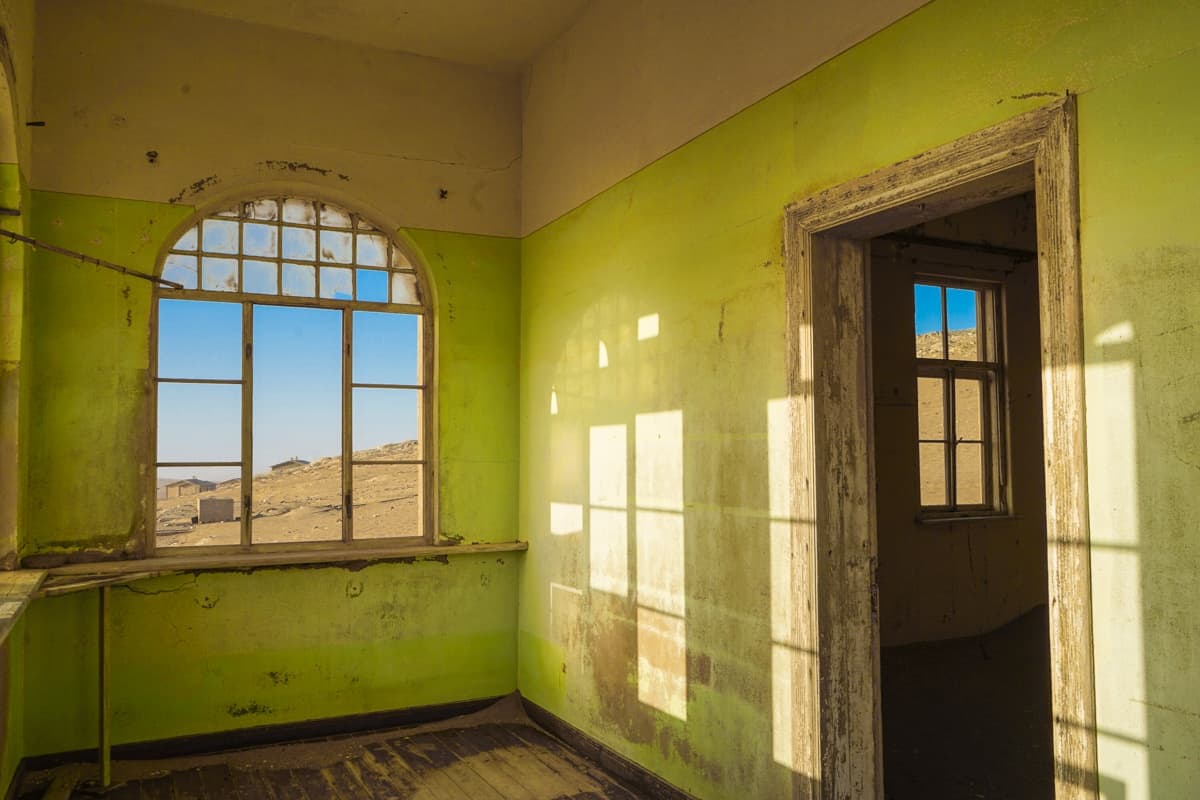
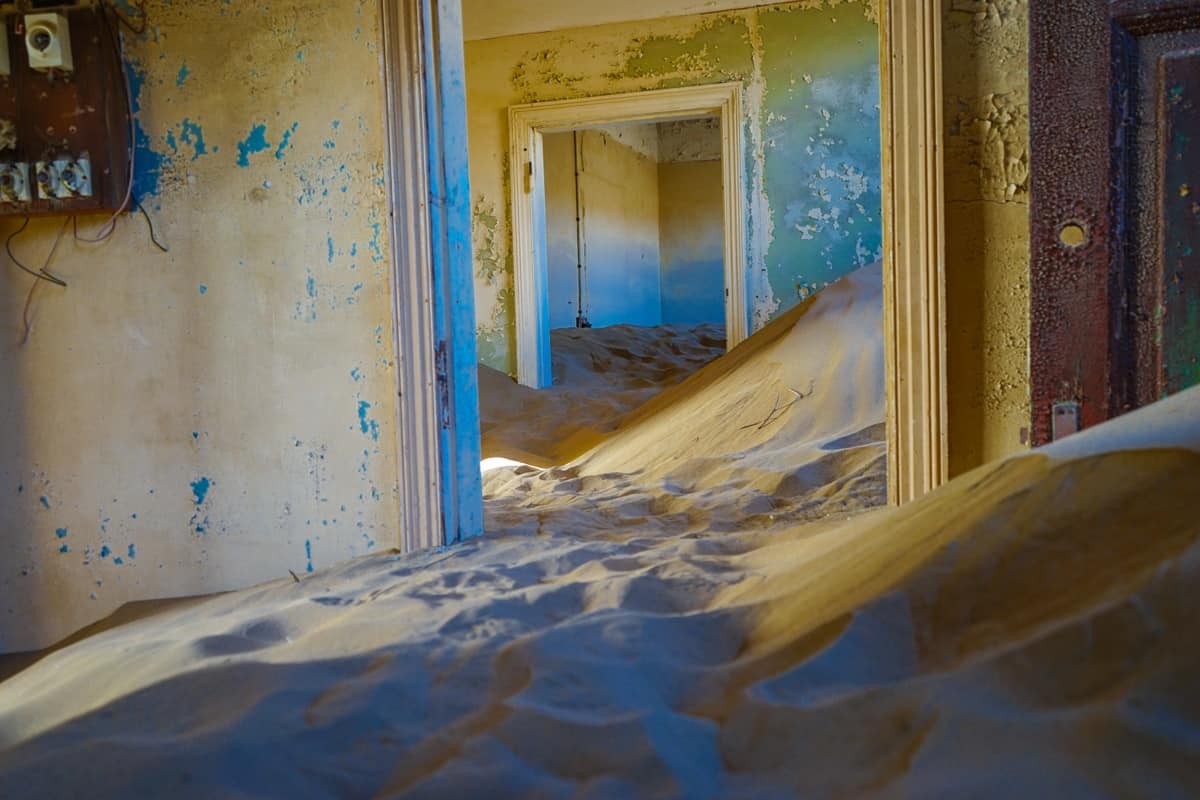
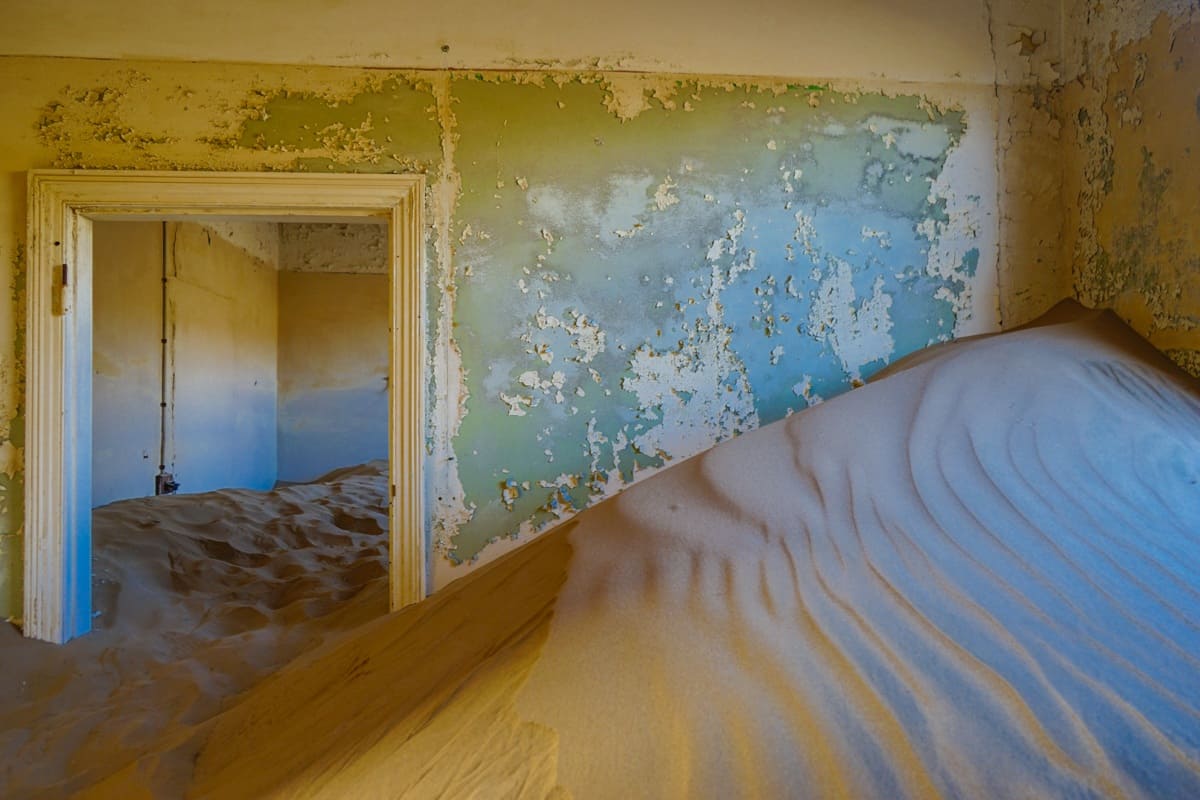
I loved that although tourists traipse through Kolmanskop all day, there’s still plenty of untouched sand to be found. The ripples in this sand dune mirrored the ones I’ve seen in deserts all across the world
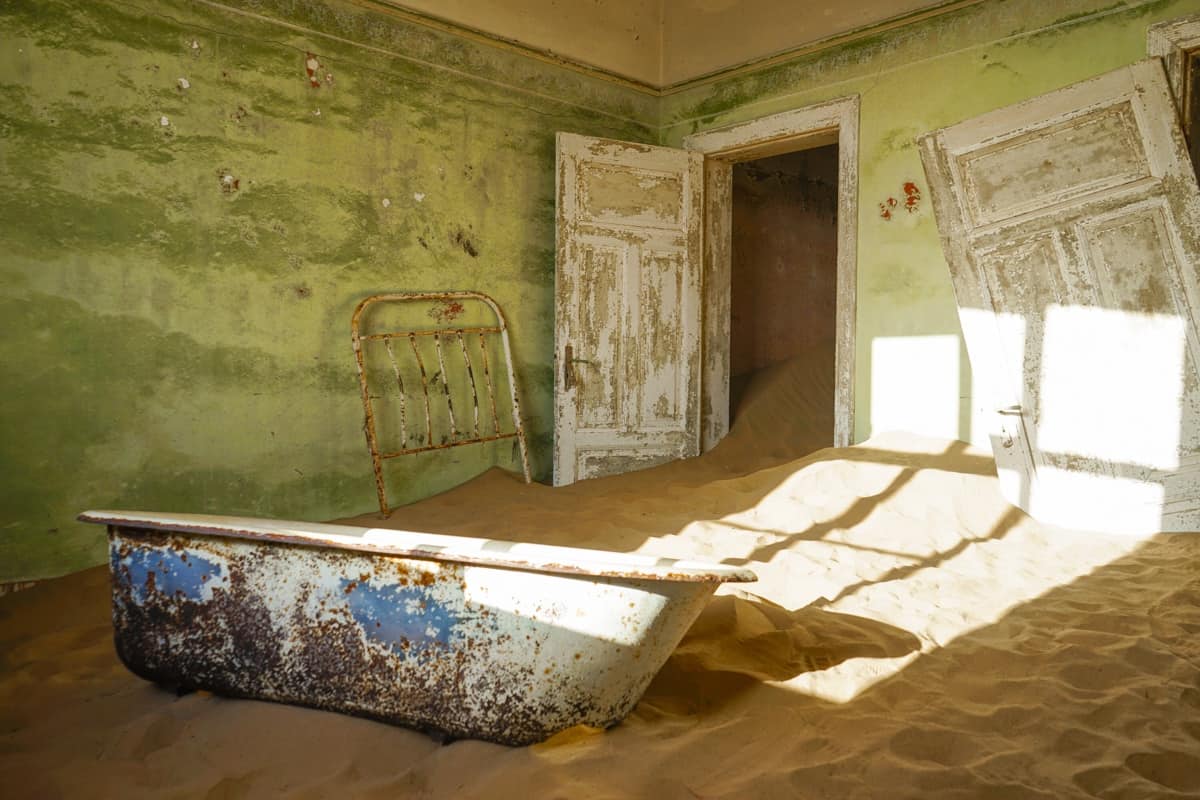
There were a handful of objects waiting to be discovered in the houses, whether it was a rusty kettle in a kitchen or this old bathtub and bed frame found upstairs in what was once someone’s bedroom.
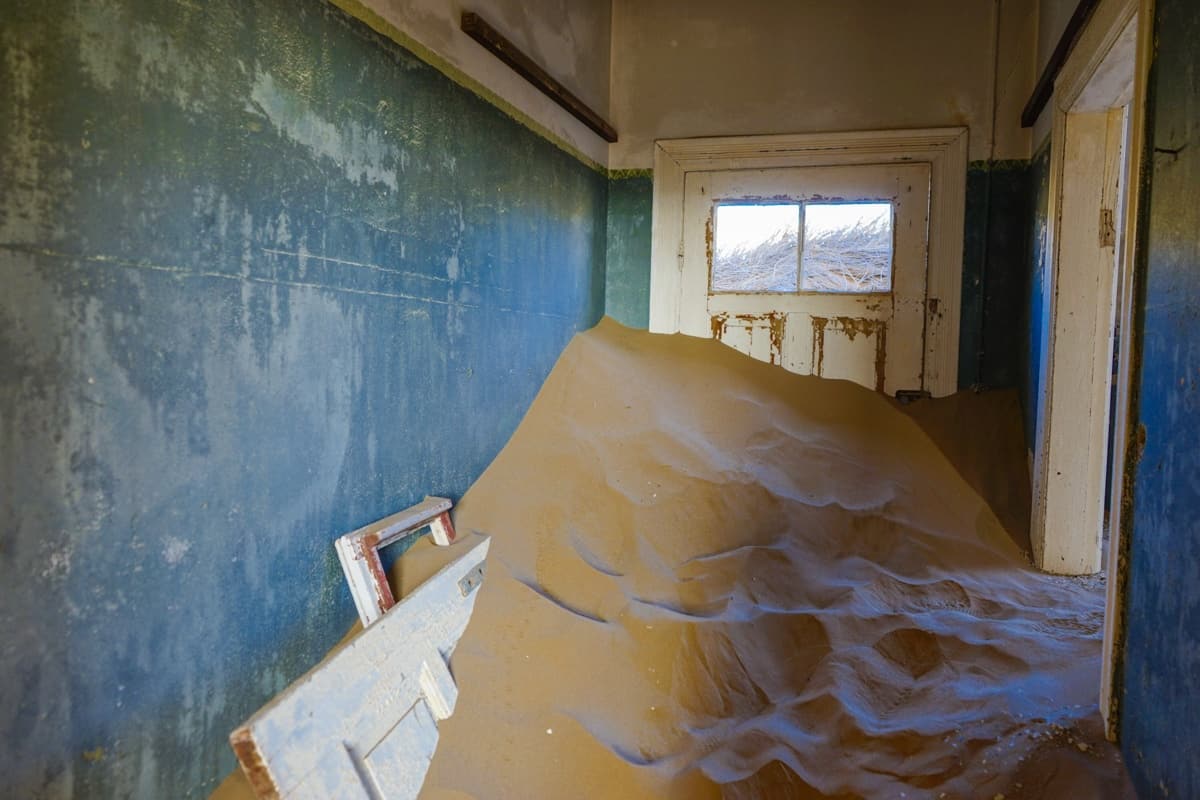
Argh! This photo makes me feel so claustrophobic for some reason. I think because it makes me feel like I’m trapped inside the house? This was definitely a building I had to enter through a window or side entrance. 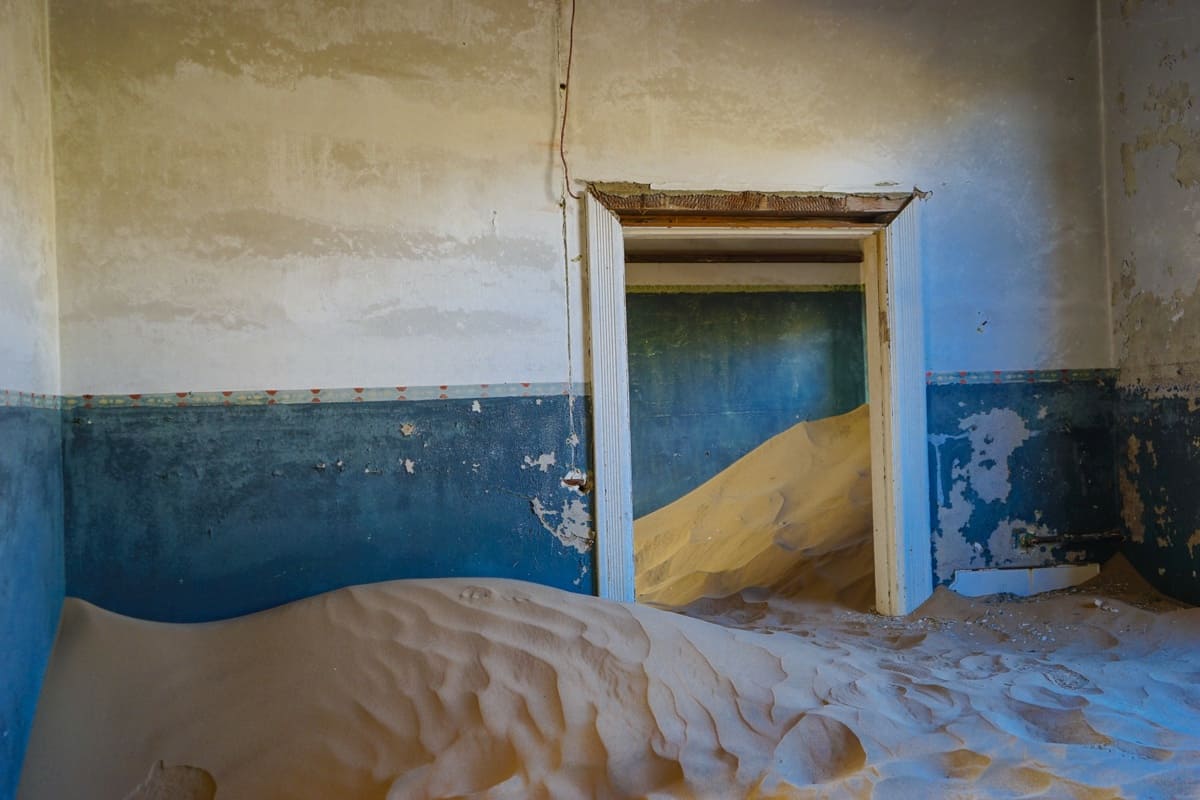
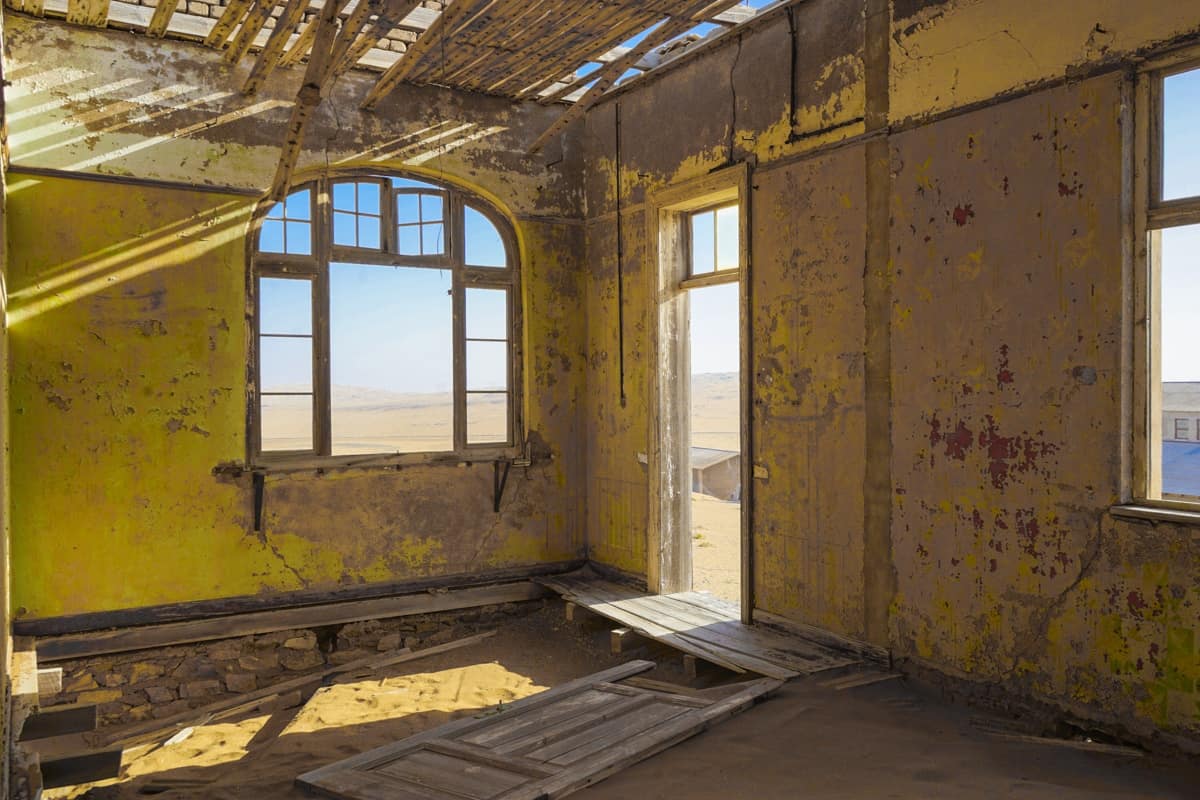
I loved the desert view from this building! Note the broken floorboards and ceiling: I definitely regretted wearing flip-flops when I realised how easy it would be to injure myself here
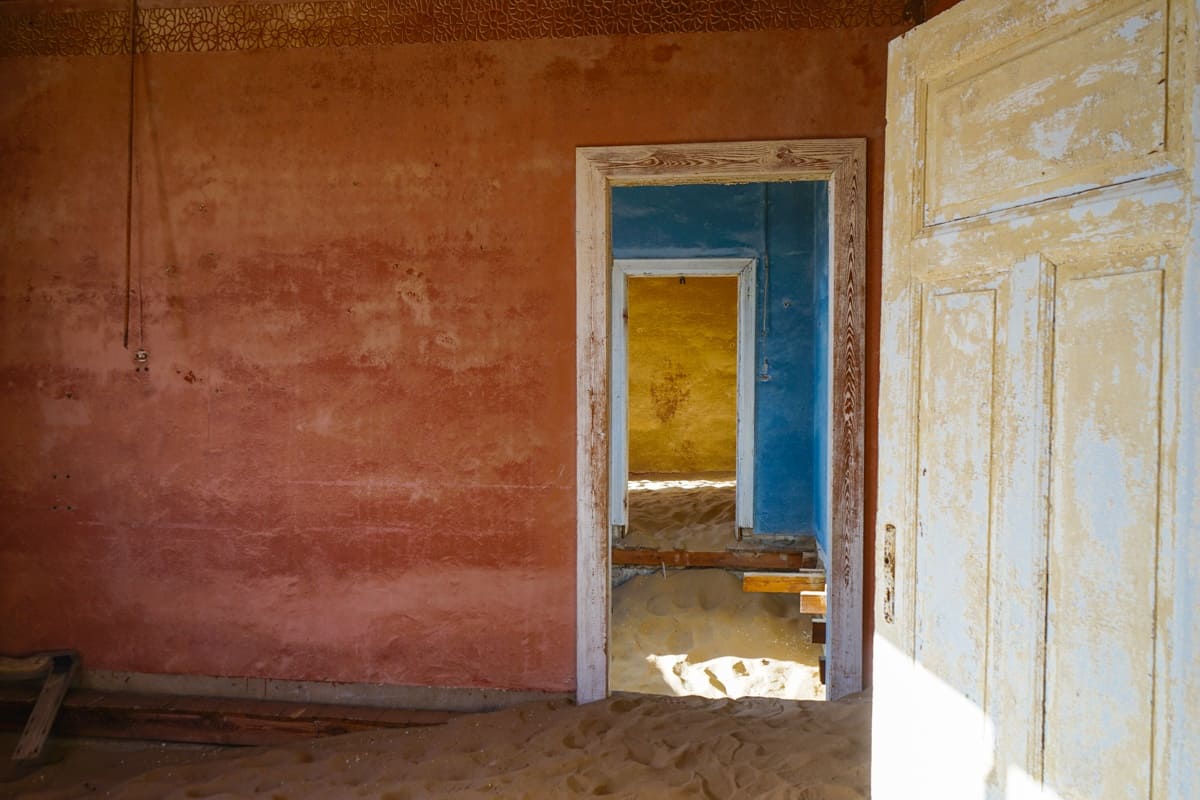
I loved how the doorless rooms made for a fun transition between the different colours in this building
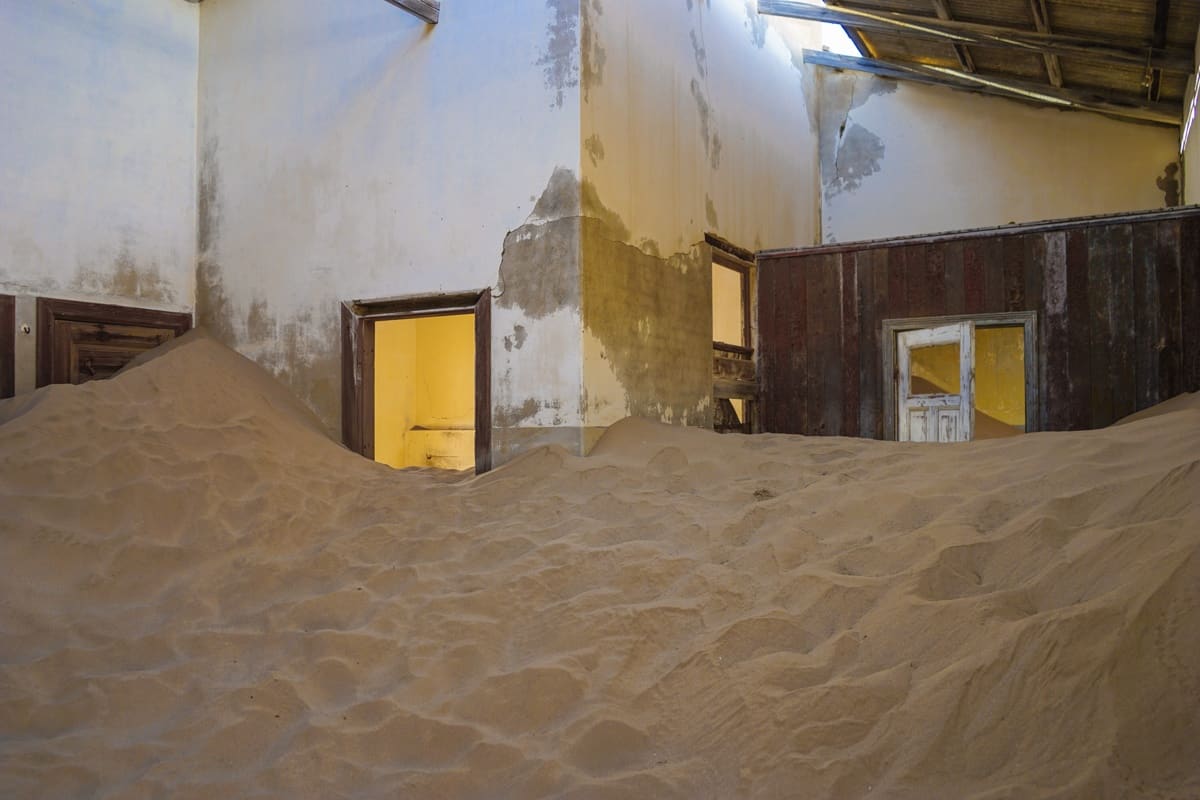
I wanted to include this photo to give you an idea of just how much sand has ended up inside some of these buildings! This one had dunes reaching up above some of the door frames!
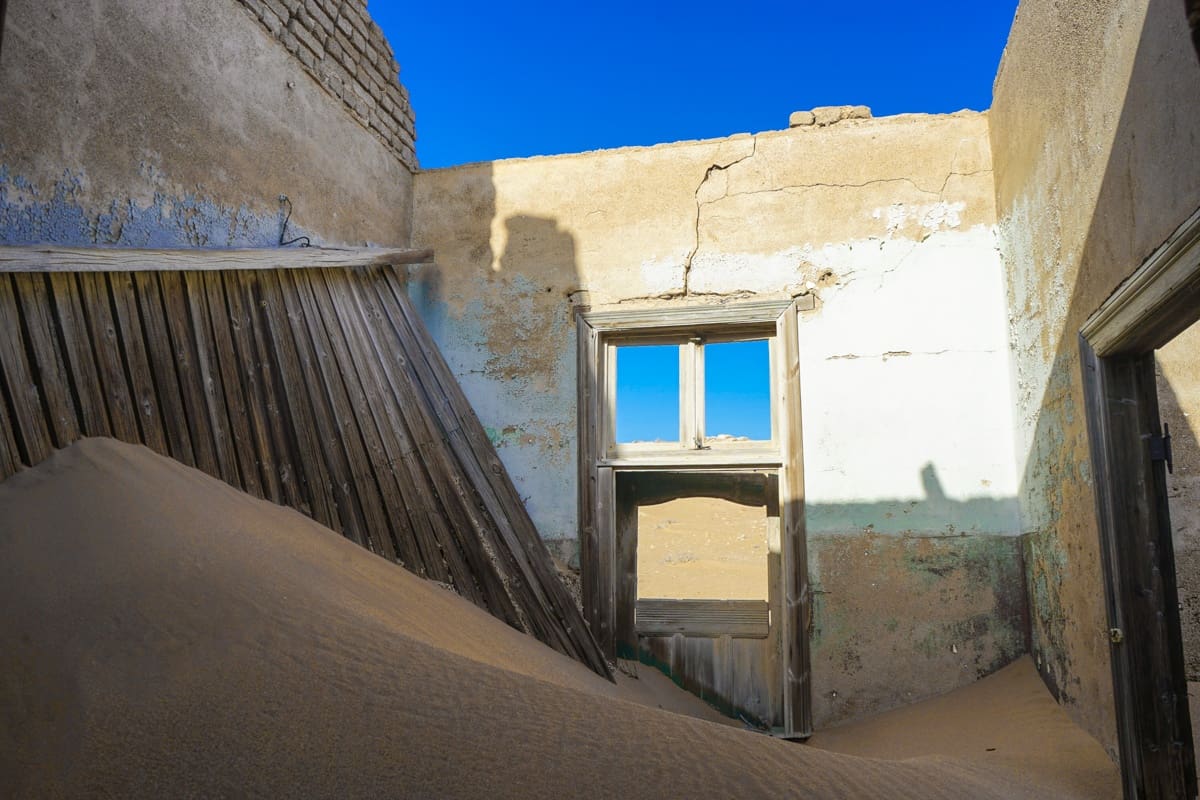
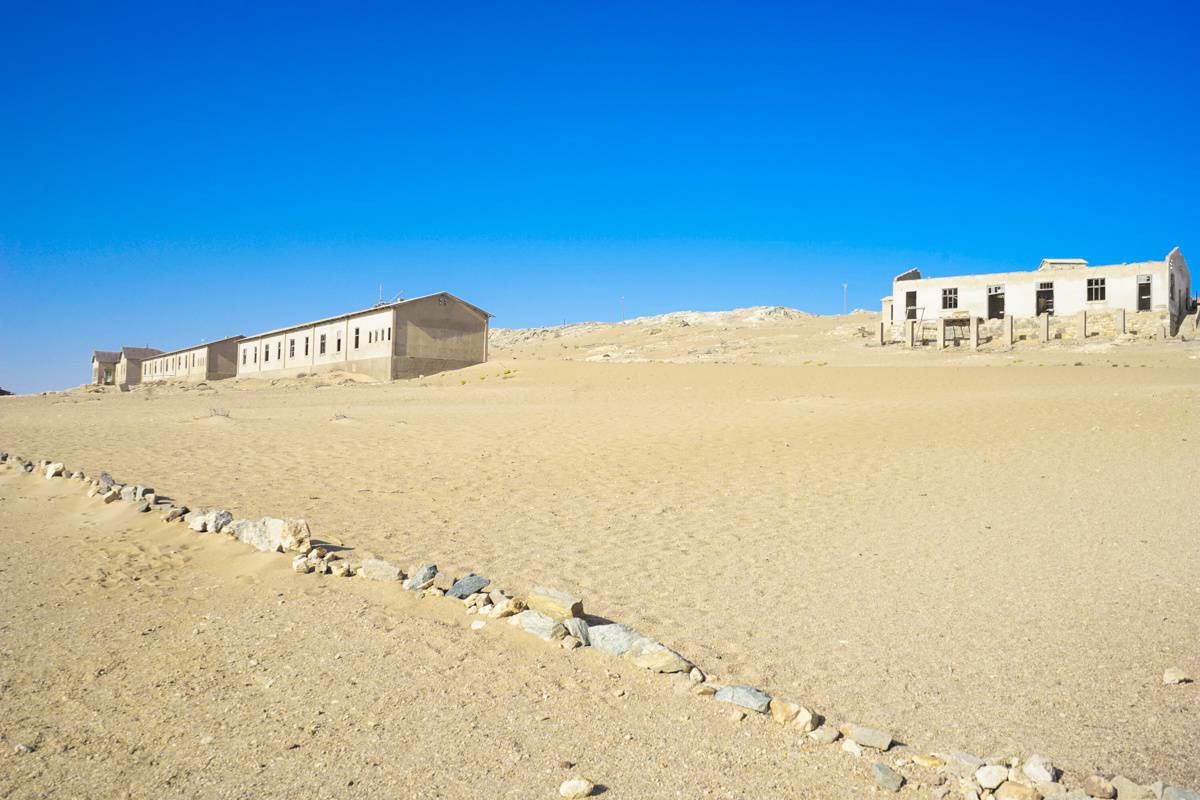
Taking a final look around Kolmanskop before jumping in the car and beginning the long journey home
When I finally felt as though I’d had my fill of sandy homes, I checked the time and was astounded to discover we’d been at Kolmanskop for four freaking hours.
By this point, the sun was beating down, the sky was a pristine blue, and the crowds were starting to arrive. By which I mean there were 30 other people wandering around instead of three.
We had a long day ahead of us.
We’d driven 300 miles from Sossusvlei to get to Kolmanskop, and had 500 miles to tackle between here and Windhoek. When I first decided Kolmanskop had to be on our itinerary, I wondered if a 1000-odd mile detour on atrocious roads would be worth it.
You guys already know it was. Over the next couple of days, I couldn’t talk about anything else. I couldn’t think about anything else.
If you ever get the opportunity to travel to Namibia, you have to go to Kolmanskop.
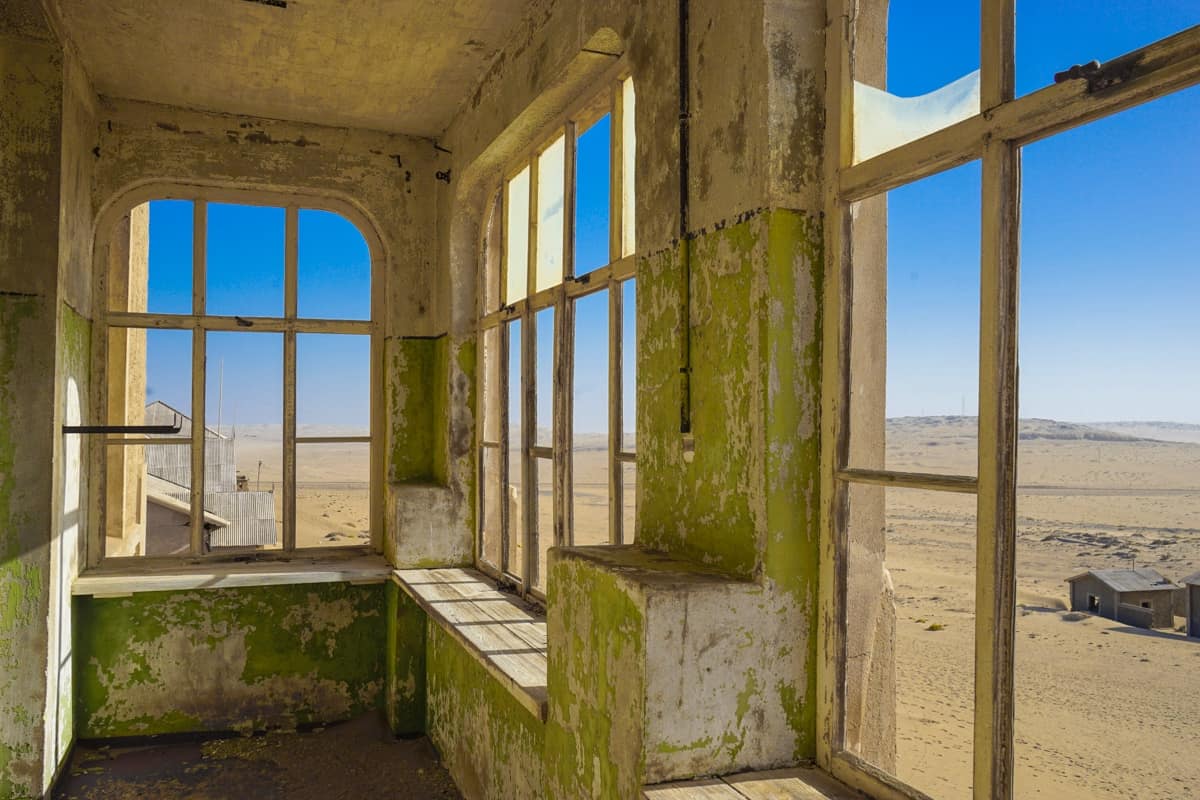
Kolmanskop: My Tips for Visiting
How to get there: Frustratingly, Kolmanskop is kind of out of the way when it comes to visiting Namibia’s highlights. Still, if you’re willing to tackle the bad roads and add an extra couple of days to your trip, it’s well worth seeing. We drove from Sossusvlei, stopping over at the lovely Betta Camp ($58 a night) for a night to break up the long drive. There’s basically only one route to take to get to Kolmanskop: from Sesriem, follow the C27 then C13 down to Aus, where wild desert-adapted horses roam free. From there, follow the B4 to Luderitz.
Where to stay: The nearest town to Kolmanskop is Luderitz — a pleasant coastal town that’s filled with German art nouveau architecture. Nearby, you can check out the bay that’s home to flamingos and pelicans. If you’re lucky, you may even spot some dolphins and penguins splashing around. If you have the time, it’s worth spending half a day wandering around the town.
We stayed at Kairos B&B ($104 a night) while we were in Luderitz. The B&B was an affordable (by Namibia’s standards anyway) and decent option on a small peninsula with a nearby flamingo colony. There was A/C, parking spaces, a clean, modern room, and a gorgeous view over the ocean. It was great!
If you’re on a tight budget, Element Riders Backpackers offers up dorm rooms for $9 a night, and private rooms from $28 a night.
How to get a permit for Kolmanskop: If you plan on visiting at sunrise, I’d recommend buying a permit in advance, so you don’t have to do as we did and break in when the guard doesn’t turn up on time. You can grab a permit from Luderitz Safari and Tours in the centre of town. They’re open from 9-6 on every day apart from Saturday, when the hours are 8:30 am – 10 am, and Sunday, when it’s closed.
A permit costs 90 NAD ($6.50 USD) to visit between 9 a.m. and 1 p.m. The photography permit is 230 NAD ($17 USD), and allows you to visit between sunrise and sunset. The latter is definitely worth the money, as getting to see Kolmanskop without the crowds is an incredible experience.
How long to spend there: I consider myself a speed sightsee-er. I usually spend half as much time at tourist attractions as others, quickly moving on because there’s so much more I want to see. I therefore thought I’d spend an hour or so at Kolmanskop before hitting the road for our next destination.
I couldn’t have been more wrong.
In reality, I spent a whopping four hours exploring this tiny ghost town. Every hour, the light in the complex changes and it makes you want to go back through all the buildings again to see how they’ll look with different shadows and tones.
Expect to spend way longer at Kolmanskop than you think. I’d say four hours is probably about the average.
There’s a cafe on site: We planned to have a late breakfast at the restaurant, but it was still closed by the time we’d finished up. So, I have no idea what the food is like, but if you stick around until it opens, it would be pretty cool to have a meal overlooking the ghost town.
It can be surprisingly cold: Namibia is a hot, desert country, but that doesn’t mean it stays scorching overnight. If you’re planning to explore at sunrise, take a jacket. I was chilly for the majority of my time there.
Make sure your camera is fully charged: You’re going to take so many photos while you’re at Kolmanskop that you’ll want to fully charge your camera the night before. I ended up taking many hundreds of photos while I was there.
Fun fact: my camera ran out of battery when I’d been at Kolmanskop for only an hour. Panic! I had to run to the car to grab my external charger, as thankfully my camera charges via microUSB. As I wandered around the ghost town, I’d be charging my camera for three minutes, taking 25 photos, then running out of battery again. It was so annoying.
And while I’m talking about cameras, you’ll want to carry a bag with you to keep your camera in while you’re scrambling through the sand. It’s too easy to get grains of sand all over your camera and lens in a place like Kolmanskop.
Sandals are a good option: The sand is reasonably tightly packed at Kolmanskop, so you don’t have to worry about wading waist-deep through the buildings. However, you’re still going to get a ton of sand in your shoes as you walk around. Sandals are going to be the best option here, as flip-flops are annoying — I wore them and had regrets — and sneakers are going to collect all the sand.
Thick soles are a necessity, as there are also random floorboards missing in buildings, and occasional rusty nails and broken glass on the ground.
If you’re going to be visiting later in the day, enclosed shoes will be the way to go, as the sand can get scorching hot during the middle of the day.
Stay safe: On that note, take caution as you walk around Kolmanskop. Buildings are falling apart, floorboards are missing, rusty nails and barbed wire can cut you up. Be aware of your surroundings and don’t take any unnecessary risks to get that perfect shot. Your life is worth more than that.
Get exploring: After the sun has risen, head back to the buildings you visited first to see them in a different light. Wander around the outside. There are side entrances and windows to walk through, and rooms you can only access from around the back. You’re free to go wherever at Kolmanskop, so make the most of that freedom.
Comments
Post a Comment